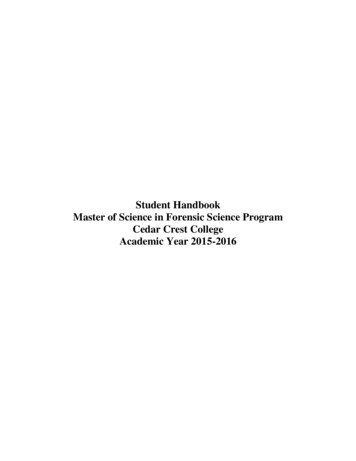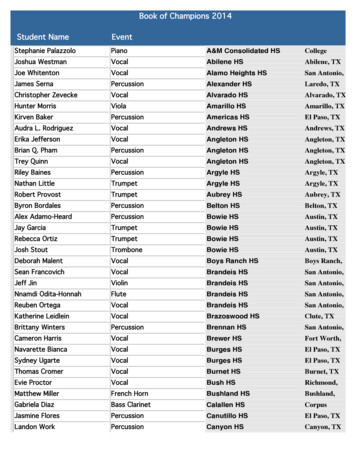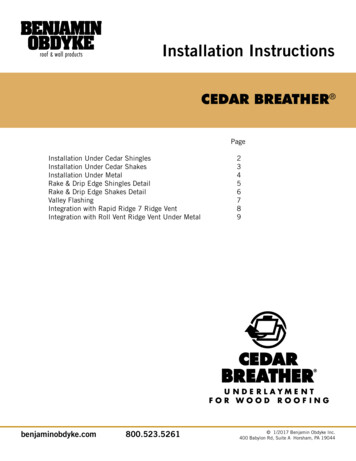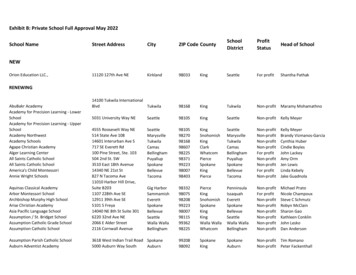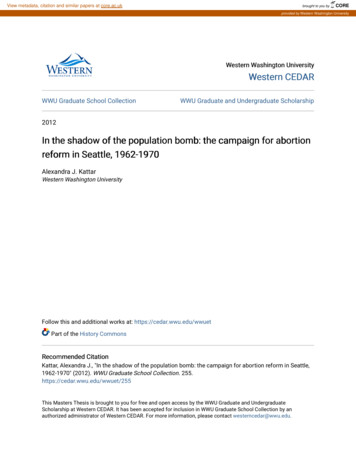
Transcription
View metadata, citation and similar papers at core.ac.ukbrought to you byCOREprovided by Western Washington UniversityWestern Washington UniversityWestern CEDARWWU Graduate School CollectionWWU Graduate and Undergraduate Scholarship2012In the shadow of the population bomb: the campaign for abortionreform in Seattle, 1962-1970Alexandra J. KattarWestern Washington UniversityFollow this and additional works at: https://cedar.wwu.edu/wwuetPart of the History CommonsRecommended CitationKattar, Alexandra J., "In the shadow of the population bomb: the campaign for abortion reform in Seattle,1962-1970" (2012). WWU Graduate School Collection. 255.https://cedar.wwu.edu/wwuet/255This Masters Thesis is brought to you for free and open access by the WWU Graduate and UndergraduateScholarship at Western CEDAR. It has been accepted for inclusion in WWU Graduate School Collection by anauthorized administrator of Western CEDAR. For more information, please contact westerncedar@wwu.edu.
In the Shadow of the Population Bomb:The Campaign for Abortion Reform in Seattle, 1962-1970ByAlexandra J. KattarAccepted in Partial CompletionOf the Requirements for the DegreeMaster of ArtsKathleen Kitto, Dean of the Graduate SchoolADVISORY COMMITTEEChair, Dr. Kevin LeonardDr. Pollly MyersDr. Kathleen Nuzum
MASTER’S THESISIn presenting this thesis in partial fulfillment of the requirements for a master’sdegree at Western Washington University, I grant to Western WashingtonUniversity the non-exclusive royalty-free right to archive, reproduce, distribute,and display the thesis in any and all forms, including electronic format, via anydigital library mechanisms maintained by WWU. I represent and warrant thesismy original work, and does not infringe or violate any rights of others. I warrantthat I have obtained written permissions from the owner of any third partycopyrighted material included in these files. I acknowledge that I retain ownershiprights to the copyright of this work, including but not limited to the right to use allor part of this work in future works, such as articles or books. Library users aregranted permission for individual, research and non-commercial reproduction ofthis work for educational purposes only. Any further digital posting of thisdocument requires specific permission from the author. Any copying orpublication of this thesis for commercial purposes, or for financial gain, is notallowed without my written permission.Alexandra J. KattarDecember 12, 2012
In the Shadow of the Population Bomb:The Campaign for Abortion Reform in Seattle, 1962-1970A ThesisPresented toThe Faculty ofWestern Washington UniversityIn Partial Fulfillment of the Requirements for theDegree Master of ArtsBy:Alexandra J. KattarDecember 2012
ABSTRACTIn November 1970, fifty-six percent of Washington State voters approved Referendum20. With this act, a state legalized abortion by popular vote for the first and only time in thehistory of the United States. This study explains how and why Washington State reformed itsabortion law. The successful political campaign, led by Washington Citizens for AbortionReform (WCAR), based in Seattle, constituted an unusual alliance of conservatives and liberals,men and women, Protestants and Catholics, often forgotten from the history of reproductivepolitics and certainly from the public debate on the issue during the twenty-first century. In theshadow of the population bomb–a postwar metaphor which conflated fears of atomic annihilationand overpopulation–a heterogeneous alliance of supporters for reform was built by Seattleites tomeet their needs of a changing urban landscape. Members of the WCAR were professionals inlaw, medicine, politics, theology, and social work as well as citizen lobbyists. This study positsthat their motivation to support the reform was shaped by their identity as a Seattleite (placeidentity), profession identity, and middle-class values in democracy, education, economicmobility, and family. Their understanding of the dilemma of unwanted pregnancies and illegalabortions was influenced by stories women told them about their need for abortion. These storiesplayed a central role in the mobilization of the reform movement. Furthermore, messages aboutoverpopulation and “healthy” sexuality informed the WCAR’s advertisement campaign to solicitvoter-approval for Referendum 20. This work argues that the science of ecology created a newlexicon and schema with which to consider population issues at the same time as a growingwomen’s movement posited a challenging critique of gender roles. Therefore, the abortionreform movement was aided by two powerful, concurrent social movements during this era–theenvironmental and women’s movements–in order to remake laws to reflect the changing needsof women in a post-industrial economy.iv
ACKNOWLEDGMENTSThis project would not have been possible without the support and guidance fromprofessors in the history department at Western Washington University, the staff at SeattlePlanned Parenthood, and my fellow graduate students. I am lucky to have been an undergraduateand graduate student at Western Washington University. So many professors have contributed tomy intellectual growth over the years and each has added something to this project. I mustacknowledge Kathleen Kennedy, who first introduced to me the history of sexuality and Idiscovered that I could combine my two passions. The hard work of Kevin Leonard, whocarefully read and edited this work, greatly improved its readability. Through a series ofserendipitous events, and with the steadfast encouragement and enthusiasm of Polly Myers inparticular, this project has evolved to be much more probing and insightful than it could havebeen otherwise. I would like to thank the history department for the opportunity to work closelywith professors as a teaching and research assistant, from which I have gained more knowledgeabout the craft of being a historian, and for a research grant which allowed me to frequent thearchives at the University of Washington. Additionally, I must acknowledge the contributions tothis project from Aaron George and Lily Fox, who were always willing to listen to me talkthrough my argument, asking me new and interesting questions. Furthermore, Cam McIntyre andCheryll McCain helped me find invaluable primary sources from Seattle Planned Parenthood.Most significant of all, I must acknowledge the contribution of my family to this work, for(unknowingly) instilling in me my lifelong curiosity about the past and for providing me a rocksolid foundation upon which I could reach higher and work harder.v
TABLE OF ction4Chapter 1: Urban Planning26Chapter 2: Family Planning51Chapter 3: The Making of a Women’s Health Issue80Epilogue: Abortion in the Real Century 21119Bibliography124vi
List of FiguresFigure 1: The Stranger, November 20044Figure 2: The Ellensburg Daily, April 197010Figure 3: Map of Washington State Counties and Approval of Ref. 2037Figure 4: The Northwest Passage, February 197077Figure 5: Seattle, January 1969106vii
PROLOGUEHistorians take unusual pains to erase the elements in their work which revealtheir grounding in a particular time and place, their preferences in a controversyMichel Foucault– the unavoidable obstacles of their passion. 1This study is the result of my historical questions, analysis of primary sources, and sometheoretical perspectives about the history of sexuality shaped by personal experiences and myown place in the course of the historical events under analysis. Why would I study the abortionreform campaign if I were not passionate about the issue; if I did not believe that it was animportant and worth subject for historians? This study is shaped by questions about thesignificance of sexuality in peoples’ lives raised while working from 2008 to 2010 with patientsseeking abortions at Seattle Planned Parenthood. Who, why, and how do women seek abortions,and what does the experience mean to them? These questions motivated me to pursue this topicas an academic.As historian Vincent Brown wrote, “Of all creative writers, historians should be the mostskeptical of claims to originality. Our words depend on so many sources that never appear in ourfootnotes – conversations with kin, friends, and casual acquaintances, the lyrics, rhythms, andmelodies of our favorite music, the mood of our times.” 2 Though it is perhaps impossible todetail all the influences upon this work, it would have certainly turned out differently had it notbeen for the three books gifted to me from Dr. Robert Cam McIntyre upon leaving my positionas a health care assistant at Seattle Planned Parenthood. Knowing I was returning to graduateschool to study the history of sexuality, he thought I might find these medical encyclopediasfrom the 1960s “interesting.” I was touched by the gesture. At the time, I appreciated the smell,1As quoted in Robert D. Johnston, The Radical Middle Class: Populist Democracy and the Question of Capitalism inProgressive Era Portland, Oregon (Princeton, N.J.: Princeton University Press, 2003), xiii-xiv.2Vincent Brown, The Reaper’s Garden: Death and Power in the World of Atlantic Slavery (Cambridge Mass.:Harvard University Press, 2008), vii.
look, and feel of old books as much as any other history buff. Nevertheless, they sat on my shelfuntil, as a graduate student, I began to think more about how to analyze these sources.Turned out they were not just any books. Inside the cover of Master’s and Johnson’sinfamous 1966 edition of Human Sexual Response and a lesser-known, two-volume, 1961encyclopedia of Human Sexual Behavior, edited by a forward-thinker in the field of sexualhealth, Albert Ellis, was the name Peter Raible, the minister at the University Unitarian Churchfor 36 years who Lee Minto, former executive director at Seattle Planned Parenthood, hadcredited with involving her in the activities of the Washington Citizens for Abortion Reform.The only markings in any of the books were ruler-straight red lines, highlighting informationregarding abortion services available in Japan. I was surprised that a clergyman was interested inhelping women access abortion. The contemporary rhetoric against legal abortion seems to boomloudest from religious voices. This source contradicted my previous assumptions about thecampaign to legalize abortion in the United States.By analyzing how and why a coalition of men and women, religious leaders,professionals, and citizen lobbyists agreed that the abortion law in Washington State needed tobe reformed, and that a majority of voters agreed, helped me to understand how access toabortion became a middle-class issue shaped by middle-class values during the 1960s. Thus, theabortion issue transcended from solely being a women’s issue. From this perspective, thebacklash against access to abortion must be understood beyond just an attack on all women ingeneral but as a broader attack about a specific ideal of middle-class motherhood.Though there were a dozen states which liberalized their abortion law before 1973,Washington is the only state that did so by popular vote and thus the new law and theproponents’ campaign had to have popular appeal. What messages about abortion would have2
the potential for broad appeal during the 1960s and what was the local and national historicalcontext which favored reform? A locally focused analysis of the campaign to legalize abortionenables scholars to understand why some ordinary Americans, in an act of civic participation,supported reform state laws regarding abortion during the 1960s. This study offers a uniquecontribution to an understudied time and place and suggests a new perspective on the history ofabortion reform.3
In the Shadow of the Population Bomb: The Campaign for AbortionReform in Seattle, 1962-1970The mood in Seattle after Election Day in November 2004 was palpably dismal. GeorgeW. Bush had just won the necessary majority of electoral votes and been reelected. There wouldbe four more years. With its thumb on the pulse of the city, The Stranger, an alternativenewspaper, freely distributed in Seattle and its surrounding metropolis, gave voice to thehopelessness (see Figure 1). “Do not despair,” the colorful message on the paper’s front coverbegan. “You don’t have to leave,” it continued, referencing a not uncommon threat to move toCanada if Bush won again. The message sought to connect to its urban audience with the words:“You may feel out of place in the United States today but you’re not.” The message comfortedits readership that they, as urbanites, did not live in “the nation.” They lived in “the city,”suggesting that cities were a special kind of place. It cited a correlation to reassure the reader thatthis was so. “The bigger the city, the higher Kerry’s percentage.” What made cities unique?Figure 1:Cities, it claimed, were “diverse, dynamic, andprogressive,” and therefore Seattleites should restassured (and stay put) because they lived in “TheUnited Cities of America.” 3 The cover of The Strangerfrom 2004 made a remarkable connection betweenplace, politics, and identity that this study of thecampaign for abortion reform highlights.In the election of 1970, Referendum 20legalized abortion in Washington by popular vote for3The Stranger, November 11, 2004.4
the first and only time in U.S. history. The impact of the campaign for abortion reform during the1960s is evident in this source from 2004. According to the The Stranger, to be an urbanitemeant being progressive and pro-choice. 4 Events explored in this paper explain how Seattlebecame a progressive metropolis by the twenty-first century, home to urbanites who supportaccess to abortion with their vote. By analyzing the campaign for abortion reform of the 1960s,the following work will show how place and identity became inextricably linked during thepostwar period in Seattle to an extent that its legacy was still visible in this colorful cover of TheStranger.Being pro-choice was one of the four critical attributes of this ideal Seattleite, accordingto this message. This particular construction of an urban identity has a history that can beanalyzed by looking at the local campaign for abortion reform from 1962 until 1970 inWashington State. Indeed, the divide between supporting or opposing the legalization of abortionwas geo-political. A majority of voters in the counties from the state’s western urban corridorapproved the referendum in 1970. Likewise today, as many who live in the state’s western citiesknow anecdotally, the boundary separating city from country is where the rainbow flags end andanti-abortion billboards begin. The following work explores how place, politics, class, andidentity functioned to create a culture favorable to abortion reform by 1970.Demonstrating the relationship between place and identity, The Stranger concluded thatSeattleites “felt out of place” only if they saw themselves as living in the United States. As themessage suggested, urbanites supposedly held such different views from the rest of nation thathad elected George W. Bush (51% of the popular vote) that Seattleites should see themselves asbelonging to a different place, the United Cities of America. Seattleites felt out of place whencontrasted against “the nation,” whose residents supported Bush and were described as4Pro-choice is a post-Roe v. Wade label to signify political support for access to abortion.5
“fundamentalist-church-going, gun-hugging, gay-bashing, [and] anti-choice,” in other words,everything that the magazine presumed its imagined readership not to be. 5 Belonging to the citydid not necessarily mean a residential address within the city’s formal boundaries but insteadrequired a constructed urban identity that was decidedly progressive. Thus, culture and placewere inextricably linked in ways that fostered an environment favorable to abortion reform in1970 still evident in 2004.The construction of a Seattleite identity required an “other” with which to contrast itself.By 2004, the “other” was the rest of America, but during the 1962 Century 21 Exposition inSeattle, which glorified an ideal metropolis of the future, the “other” was rural America. In 1962Seattle hosted a World’s Fair at a time when many Americans had migrated from rural south andmid-west to the cities in the west and this event helped to create a particular vision of a utopianmetropolis that embraced science, scientists, and the scientific method in a way that madeabortion reform more favorable as a measure of “progressive” reform. In part, the abortionreform campaign in Seattle was a response to the city’s own “population explosion” after WorldWar II as the city welcomed hundreds of thousands of new residents born out-of-state, thoughwith some apprehension. Apprehension towards growth led to support for Referendum 20 asfamily planning became understood by some voters as a measure of urban planning. This worksuggests that the campaign for abortion reform was an example of how some Seattleites workedto make the city into an ideal imagined during the World’s Fair.The intention of this work is to uncover why a majority of Washington State votersapproved abortion reform by referendum in 1970, the result of a campaign effort led by themembers of Washington Citizens for Abortion Reform (WCAR) based in Seattle and run bySeattleites. To accomplish this, it seeks to understand the process through which Seattle became5The Stranger, November 11, 2004.6
a progressive metropolis during the postwar era. 6 This study contextualizes primary sourceswhich portray the city in popular print and images in ways that sought to create a more hopefulfuture. It finds evidence of Seattleites who discussed their reasoning for supporting abortionreform in ways that reflect the perspective that moving from an “archaic” past and into a brightfuture required decriminalizing abortion and, in so doing, allowing experts to perform theprocedure in hygienic hospitals. Some supporters of abortion reform, like Stacey Brown,wondered what kind of place tolerated women in “the hands of some butcher” because of an“out-needed law”? 7 Indeed, Americans during the postwar era were hard at work thinking aboutwhat kind of place America should be just as the nation entered the world stage as a powerfuleconomic and political force. 8This study considers the tension between images of the ideal city and family and thereality of American cities and middle-class families in transformation in the postwar era and howthis tension motivated some to act in ways that supported reforming the state’s abortion law. Tocontextualize the local campaign for abortion reform, this study analyzes how ideas regardingabortion were shaped by discussions of progress and place in addition to new ideas about ahealthy planet and healthy families during the postwar period.By the 1960s, a critical mass of predominantly white, middle-class Americans began toarticulate new ideas from the growing environmental and women’s movements that6Acknowledging that the meaning of “progressive” is not static but in perpetual formation through negotiatingand contestation, this study takes seriously the ways in which historical actors understood the concept and howthey acted upon its ideals. This matter will be explored further in Chapter 1. For example, readers may be surprisedto discover that key members of the Republican leadership team at this time, such as Joel Pritchard, Slade Gorton,and Mary Ellen McCaffree supported Referendum 20. Republican Governor Dan Evans’ political platform, called“The Blueprint for Progress,” included environmental protections that would today be unlikely to be endorsed bythe Republican Party. Being “progressive” during the 1960s was not synonymous with being a Democrat. Thisstudy investigates a time and place in which abortion was not a partisan issue.7“Letters, Incoming” Folder 2, Box 3, Washington Citizens for Abortion Reform records, 1963-1970, University ofWashington Special Collections.8For more on the relationship between the international and domestic cold war context, see Elaine Tyler May’swork, Homeward Bound: American Families in the Cold War Context (New York: Basic Books, 1988).7
fundamentally rethought the human relationship with the earth and the relationship betweengenders. The evidence shows that some individuals reasoned that abortion reform was necessaryby using a new lexicon popularized by these movements, such as “the stork is out pacing theplow” and “every woman has the right to choose.” 9 This study takes seriously how politics andculture shape human behavior, especially for the middle class. 10 As the population of the Seattlemetropolitan area from Everett to Tacoma increased, so too did middle-class anxiety towards theconcrete construction of a growing urban infrastructure and the threat this growth posed to ahealthy planet and healthy families. While a growing economy was precisely the reason whymany migrants arrived in Seattle between 1945 and 1970, middle-class professionals began toworry about the consequences of growth in ways which made them receptive to supportingpublic policies which enabled smaller family size. Thus, the campaign for abortion reformshould be seen as an effort by citizens to create limits to growth of the city and family sizeduring the postwar period.Understanding the Shadow of the Population BombThis work is organized into two parts. The first two chapters explain the condition ofcities and middle class families in the United States after World War II, and the last chapterargues that the abortion reform campaign succeeded because its supporters described it as way toprotect women’s health, which they insisted would be good for growing cities and middle-class9The first comes from an advertisement for Planned Parenthood clinic hours at the University of Washington’sStudent Health Center posted in the school’s UW Daily. The second phrase is from an advertisement created bythe WCAR for the Ellensburg Review.10I do not presume a homogeneous middle class. Other scholarship has rightfully acknowledged that “middleclasses” is a more accurate description. However, this study focuses upon a segment of the middle classes; white,university-educated, professional men and their wives (who may or may not have had salaried work, but who werethrough their marriage tied to their husbands professional social circle and thus class expectations), and urban. A.Ricardo Lopez and Barbara Weinstein, eds., The Making of the Middle Class: Toward a Transnational History(Durham: Duke University Press, 2012), and Johnston, The Radical Middle Class.8
families. By the end of the 1960s, many middle-class Americans expected to be able to plan theirpregnancies just as they believed that a large family would hinder their aspirations of materialaffluence, as well as social and class mobility. Therefore, the following work begins with ananalysis of the 1962 World’s Fair in Seattle in order to understand what kind of place the middleclass imagined to be hospitable, as explained in chapter 1. 11Likewise, beginning with the interwar period, but especially after the Second World War,academic and popular literature grew increasingly critical of motherhood as a lifelong occupationfor women. 12 An issue explored in chapter 2, participants in the feminist movement called forgreater economic and social opportunities for women in society and argued that control overreproduction was a necessary prerequisite for this possibility. Images of marriage, the family,and motherhood during the 1960s reflect the construction of family planning and limited familysize as a new middle class ideal. As this study makes clear, abortion was decriminalized becausemiddle class women, despite the law, were already having abortions. By the 1960s, with thepopularization of the science of ecology, the middle class became increasingly worried that toomany people threatened their material affluence in a world of limited resources and this providesthe ideological framework for a heterogeneous alliance of support for the movement. As Seattlevoters considered Referendum 20, they confronted the conflict between images of the ideal cityand ideal family against the reality of the seemingly endless urban and population growth if leftunchecked.11For a more complete discussion of middle-class aspirations, see Lizabeth Cohen, A Consumers’ Republic: ThePolitics of Mass Consumption in Postwar America (New York: Vintage Books, 2003), especially 212-226.12For more on this subject, see the first chapter of Rebecca Jo Plant, Mom: The Transformation of Motherhood inModern America (Chicago: University of Chicago Press, 2010).9
Chapter 1, “Urban Planning,” begins with an analysis of the 1962 Century 21 Expositionas a mega-event which functioned to create an imagined community–the metropolis–and aculture in Seattle favorable towards university-trained professionals as the preferred authoritieson matters related to sex. 13 The evidence suggests that ideas about what kind of place Seattleshould be shaped citizens’ views of abortion reform legislation. Chapter 2, “Family Planning,”analyzes transformations in the middle class and explains why middle-class men and womensupported abortion reform. This chapter argues that images of white, middle class-familiesshaped the campaign for abortion reform just as these images helped to transform the idealfamily into an affluent married white man and woman with two planned children (see FigureFigure 2:2). 14The final chapter, “The Making of a Women’s Health Issue,”outlines the WCAR’s campaign that put abortion to a vote of thepeople in 1970 and suggests its legacy into the twenty-first century. Itconsiders the vital contribution of local clergymen and members of themedical community, which added a powerful legitimacy to thepolitical campaign. The evidence suggests that some doctors and religious leaders supportedabortion reform because of their professional responsibility to serve women’s bodies and souls.Therefore, these professionals defined the campaign for reform as predominantly a women’shealth issue rather than as a women’s rights issue. The evidence suggests that this aided thesuccess of the campaign.13I rely upon the work of sociologist Maurice Roche to consider the function of the Seattle World’s Fair. MauriceRoche, Mega-Events and Modernity: Olympics and Expos in the Growth of Global Culture (New York: Routledge,2000).14“Ephemera,” Box 1, Folder 16, WCAR, UWSC.10
Because Washington State’s abortion laws were reformed by referendum, this local casestudy analyzes and synthesizes rich primary sources to consider the significance of abortionreform in the history of postwar America. This study relies upon archival material from theWashington Citizens for Abortion Reform and Seattle Planned Parenthood as well as personalinterviews conducted with people close to the campaign, including two interviews by the author.In order to understand why abortion reform passed in 1970, the study begins by analyzing whymembers of WCAR and the Washington State Legislature supported reform. The sources revealthat stories about women who needed abortions compelled people to support the campaign.Because of the referral requirement of therapeutic abortions, lawmakers had created a system inwhich women seeking abortions during the postwar period had to tell their stories and thusstories moved from congregants to clergymen and from patients to psychiatrists or physicians. Indoing so, they had unknowingly set in to place a structure which set into motion the campaignfor abortion reform. Knowing the power of personal stories, the WCAR actively sought “casestudies” from local physicians in their investigation into the issue beginning in 1967. Citizenswrote letters to the WCAR’s campaign office in downtown Seattle, volunteering stories of theirown illegal abortions or retelling other women’s stories. In 2000, Seattle Planned Parenthoodconducted an oral history project to record the early years of the local affiliate. The uneditedtranscripts from this oral history project contain the same pattern and many members on theboard at Seattle Planned Parenthood were also involved with the WCAR. The evidence is clear.Women’s stories motivated people to change the law in Washington because.This study finds that stories about unwanted pregnancies and illegal abortions werecrucial in the politicization of members of the WCAR. They drive the tone and direction of thishistory because they drove the campaign during the 1960s. In the beginning of each chapter is a11
WCAR member’s recollection of one of these stories. In choosing which story out of many torecall, the activists revealed which story was meaningful to them. They are used in the followingstudy to understand which particular stories, reconstructed in what exact way, motivated theirpolitical involvement with the WCAR and Referendum 20.These stories are used in three ways in the following study. First, these stories are used toilluminate how the activists understood their participation in the reform effort. The storiessuggest that members of the WCAR were motivated because unwanted pregnancies created adilemma for the pregnant woman as well as the professionals whose job it was to serve them.Second, these stories are used to understand how the speakers reconstructed the dilemma ofunwanted pregnancies and illegal abortions. As feminist and psychologist Carol Gilligan pointsout, “the way people talk about their lives is of significance the language they use and theconnections they make reveal the world that they see and in which they act.” 15 Thus, reproducingthese stories in their entirety reveals how abortion was understood by these historical actors inorder to understand how they shaped their actions. They are ind
WWU Graduate School Collection WWU Graduate and Undergraduate Scholarship 2012 In the shadow of the population bomb: the campaign for abortion reform in Seattle, 1962-1970 Alexandra J. Kattar Western Washington University Follow this and additional works at: https://cedar.wwu.edu/wwuet
